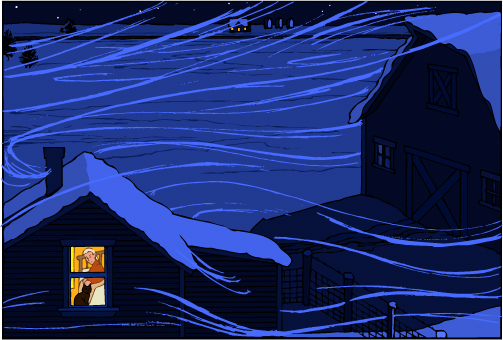Lesson 4.3D: Non-fiction Stories - Reporting the Earthquake!
 When we read a piece of non-fiction, the characters become so true to life for us. The setting and the atmosphere are often recognizable, and we can find ourselves easily empathizing with the joys and trials of the characters. When we read a piece of non-fiction, the characters become so true to life for us. The setting and the atmosphere are often recognizable, and we can find ourselves easily empathizing with the joys and trials of the characters.
In addition to the setting and atmosphere, the distinction between fact and opinion is vital in non-fiction. The reader has to be able to discern fact from opinion in order to determine what is objectively true, and what has been clouded by opinion.
As you progress through this lesson, consider how setting and atmosphere, and the distinction between fact and opinion, contribute to a reader's ability to empathize with the characters and engage with the story.
You will take on the role of a journalist reporting on an emotional event, bringing to life real characters and setting in order to write a newspaper article.
Why Do We Feel When We Read?
The emotional world of humans is complex. Just think of the endless number of feeling words. Happy, sad, angry, disgusted, excited, irritated, relaxed. When we read, we respond with an array of emotions. But just what is it that makes us feel when we read? We relate to the characters, get involved in the conflict, enjoy the surprises in the plot, and react to an overall feeling. Where does this overall feeling come from? One of the places this comes from is the atmosphere. That's the feeling you get from the place you are in.
The setting of a story also makes you feel something as a reader. The setting is how the place of the story is described, what words and phrases explain the "where" of a story. For example, a story set in war-time London, shortly after a bombing attack, might have a frightening or stressful atmosphere, and use plenty of tense, descriptive phrases. Whereas a story set at an idyllic lakeside beach might have a joyful and relaxing tone, and easy going language.
Read the following excerpt and the commentary that follows to better understand the relationship between atmosphere and setting:

Her loneliness was only made all the more real by the fact the nearest neighbour was three miles away. She could barely see the light in the Jensen's homestead on a clear night, and during a blizzard, everything was an enveloping whiteness, like tonight. Very few people came to visit during the winter. Travel was difficult, and you could get lost in the blizzard, probably never to be found until spring thaw. The days were always busy, but since Herman died, she had no one to talk to save the cat. Amelia felt like an insignificant speck in a hostile universe of white.
Commentary: In this passage, the setting is on a farm in the winter. There is a blizzard, and the character, who is alone, feels even more isolated. The author uses the setting to emphasize this mood of loneliness and despair. This sense of loneliness would probably not be as effective if the main character were living in an apartment building in a crowded city in the summer.
Emotion words are used to describe atmosphere. In this lesson we are going to read a short story that takes place during a terrible earthquake. While you are reading, think of what emotion words come to mind.
However, know that the setting is not always directly matched with the atmosphere. Writers also like to put setting and atmosphere in opposition sometimes to show how joy can come out of disaster, and deep suffering can exist in a seeming paradise.
| Discussion Prompt |
| How do you feel when you read about a disaster in a far away place? What goes through your mind when you see TV news coverage of a terrible disaster? Do you ever feel that your emotions are being manipulated? |
Guidelines for contribution:
Use plenty of examples to support your ideas. Describe at least one example in detail. Respond to at least one other student's opinions. Click here to add your entry now.
|

Stop here and read "Earthquake" by Jack Hodgins on page 350 of your Sightlines 10 textbook.
|
This story of how one family experienced the earthquake that rocked Vancouver Island, particularily the Comox Valley, in 1946, uses plenty of rich description to bring to life all the intense details of that morning's devastation and confusion.
As a reader, you will have a strong sense of atmosphere and setting in mind after reading "Earthquake."
Consider the following quotes from the story, and how each one gives you a clear image of the atmosphere and setting.
- "Do you remember how the post office, which was the only brick building in the entire valley, collapsed in a heap of rubble where it had stood for twenty years?"
- "Two Guernseys (cows) dropped directly to their kness and started to bawl, a third went staggering sideways down the sloping earth and slammed into the cedar shake wall of his barn."
- "The bricks stopped falling. The house settled. Not a sound could be heard."
Each of these three quotes give you a sense of the setting and the atmosphere. The earthquake description is both frightening and funny. Because everyone is unhurt in the end, the overall atmosphere is one of relief!

Journal Entry 4.3C: News about Disasters
Think of a time that you have seen or read a news report on a natural or man made disaster: for example, an earthquake, tsunami, or fire. When you saw or read the events of the story, what did you feel? How effectively were the atmosphere and the setting described? Were you able to picture the events for yourself? Did you feel as if you were there?
|
 What, Exactly, Is the News? What, Exactly, Is the News?
You've just read a fictional short story that uses atmosphere and setting to help readers better understand what it was like to experience the real 1946 earthquake in the Comox Valley. Non-fiction is writing that presents itself as fact. The presentation of facts may be accurate or not, but the author, at the time of writing, assumed that they were presenting the truth. An everyday example of a non-fiction story is the news report.
"The News" is the new events and happenings of the day. Newspaper writing and news channel reporting claim to be the providers of the facts about those events. Unlike short stories that focus on the development of plot, character, and atmosphere, news stories focus their attention on the 5 W's - who, where, what, when and why - are supposed to be explained by news reporters. These basic facts make up a form of writing called non-fiction.
Fact or Opinion - Preparing to Report
In your section assignment you are going to prepare a newspaper report about the earthquake events described in the short story, "Earthquake." In order to prepare to do so, you need to understand atmosphere and setting and review the concepts of fact and opinion. As we have discussed atmosphere and setting, let's take a minute to review the difference between fact and opinion.
A fact is something that can be confirmed with evidence. For example, in 2010 the winter Olympics will be held in Vancouver, BC. We can easily verify this fact. Facts are often collected in government censuses, scientific studies, and various research studies.
An opinion is someone or some group's belief or viewpoint. It cannot be proved or verified in any way, although the opinion may be based on the consideration of some facts. For example, many people believe that the Olympics is a waste of taxpayers' money. Just as many people believe that the Olympics will be a boon to the BC economy. Opinions can be found in Letters to the Editor in local papers, on blogs, and in much of day-to-day discussion.
Fact and opinion can also be all mixed up together, making it difficult sometimes to know what a person or a writer is trying to accomplish. For this reason, it is important to be able to quickly discern the difference between fact and opinion.
Summary
Completing this lesson has helped you to:
- consider the influence of atmosphere on a short story
- distinguish between fiction and non-fiction
- differentiate between a fact and an opinion
- experience writing a newspaper article
|

